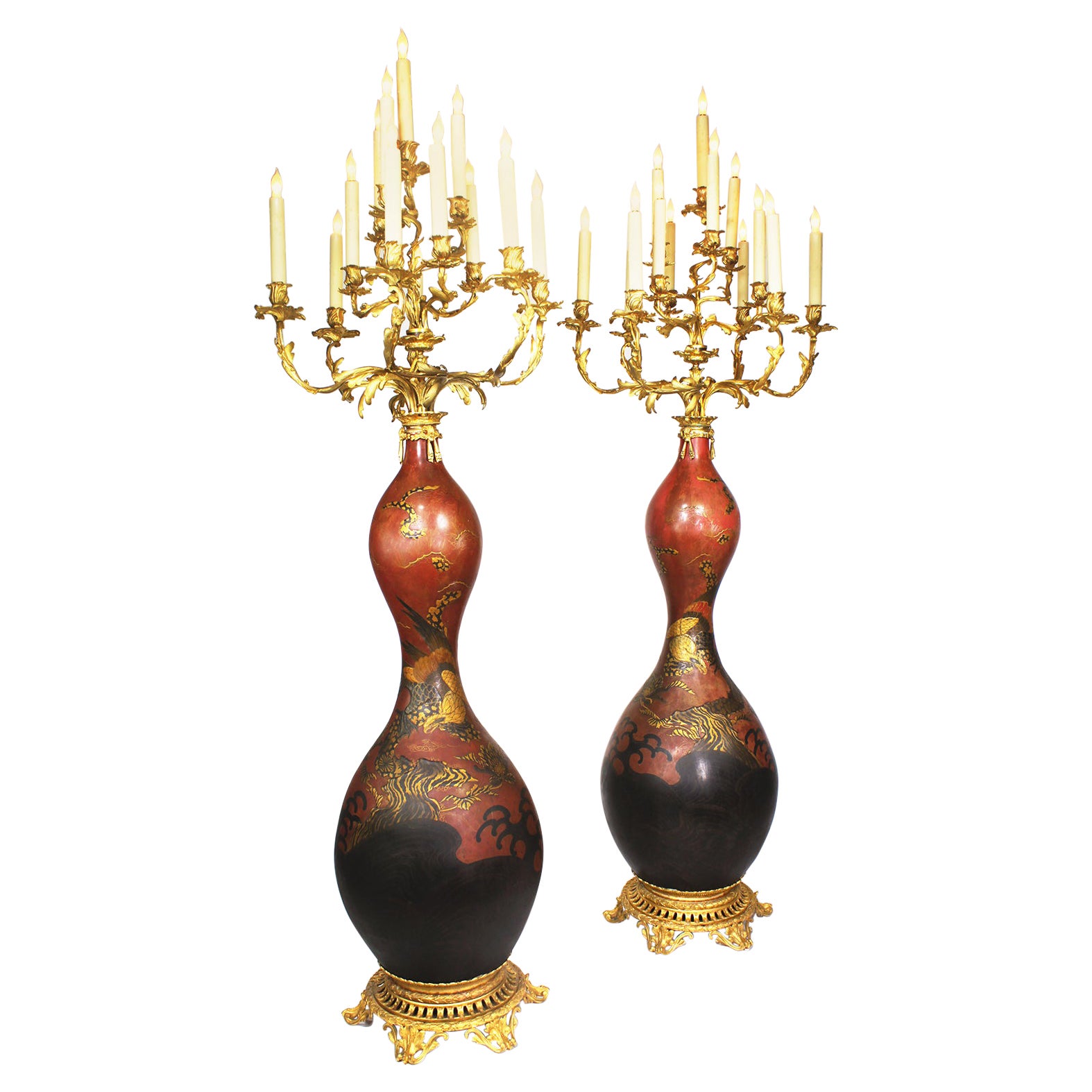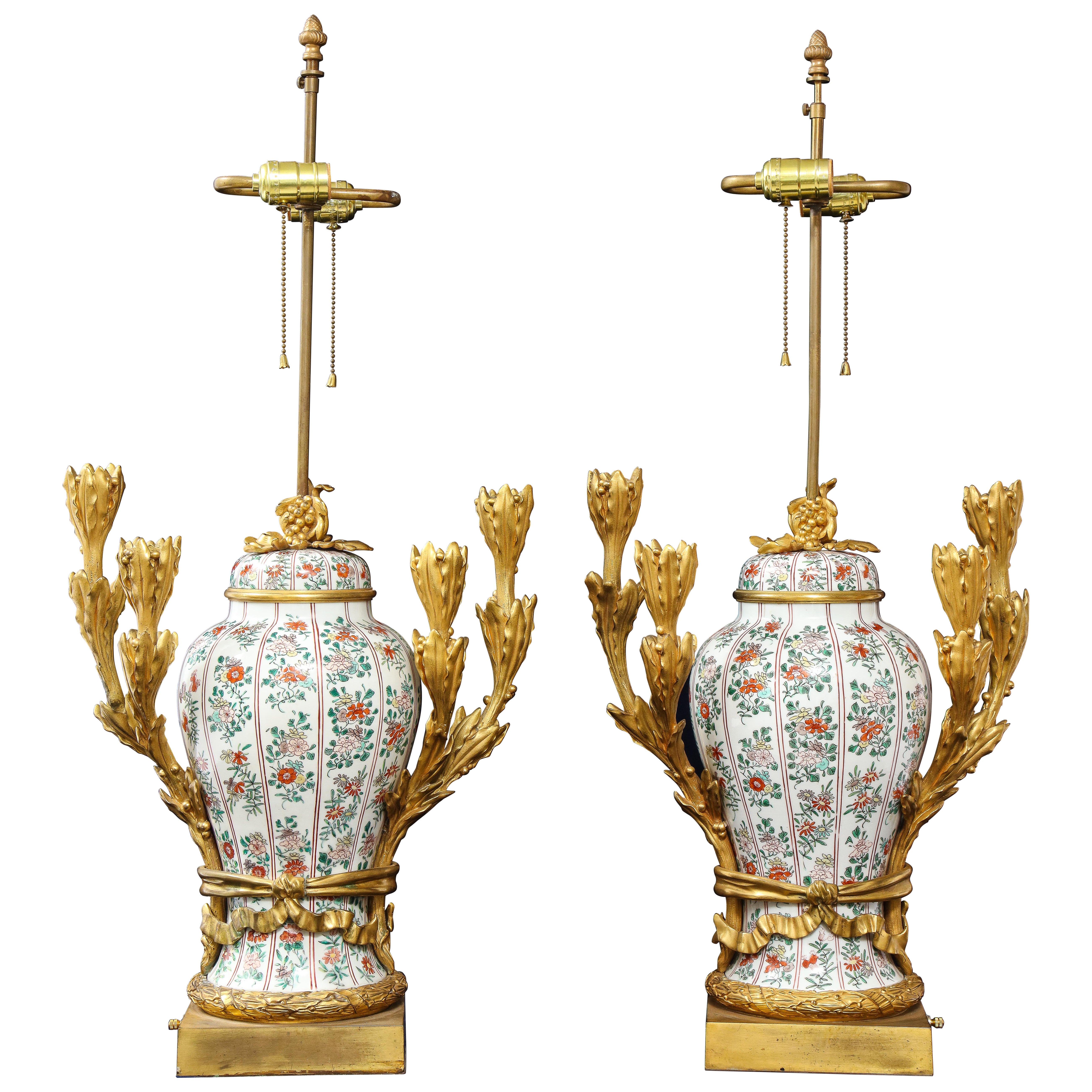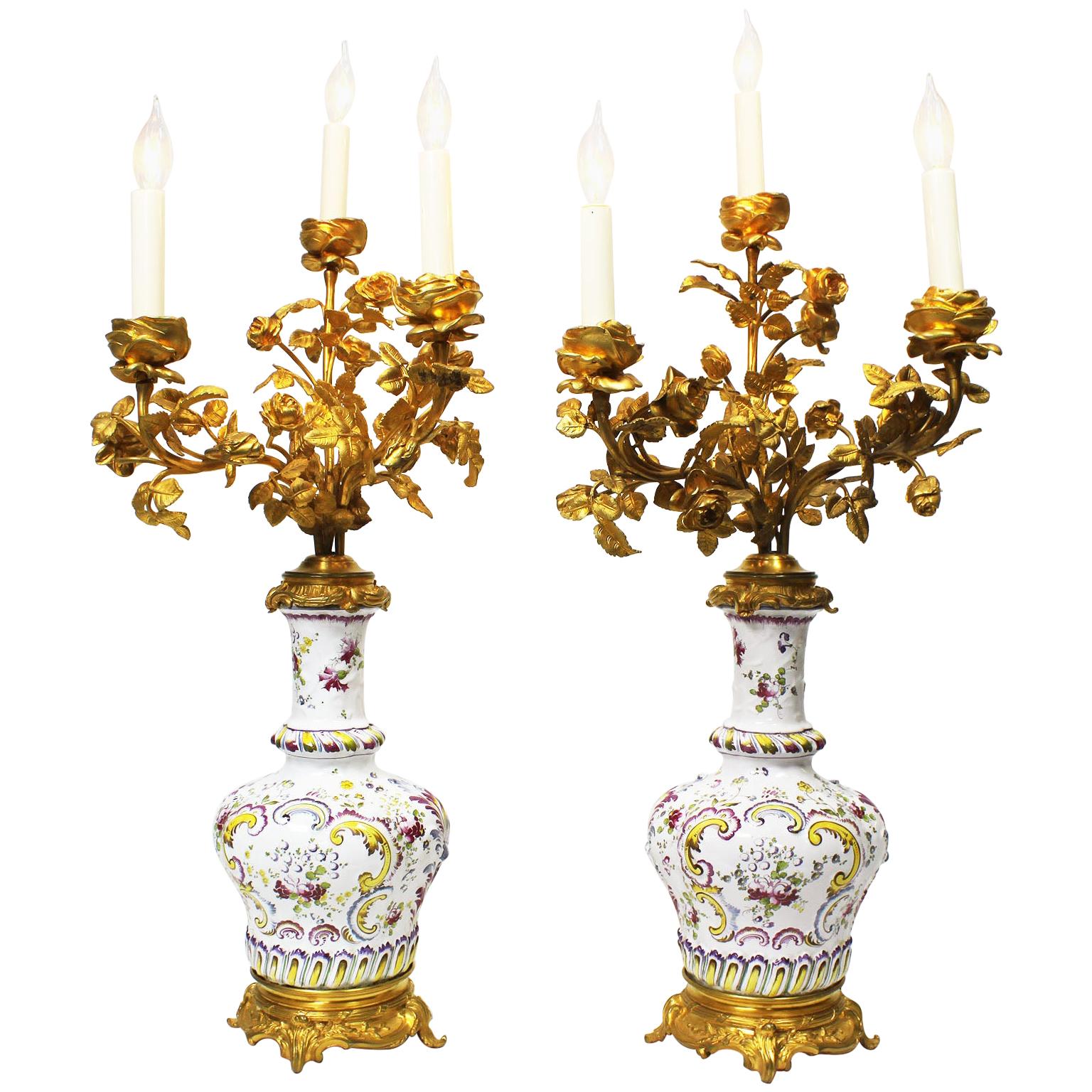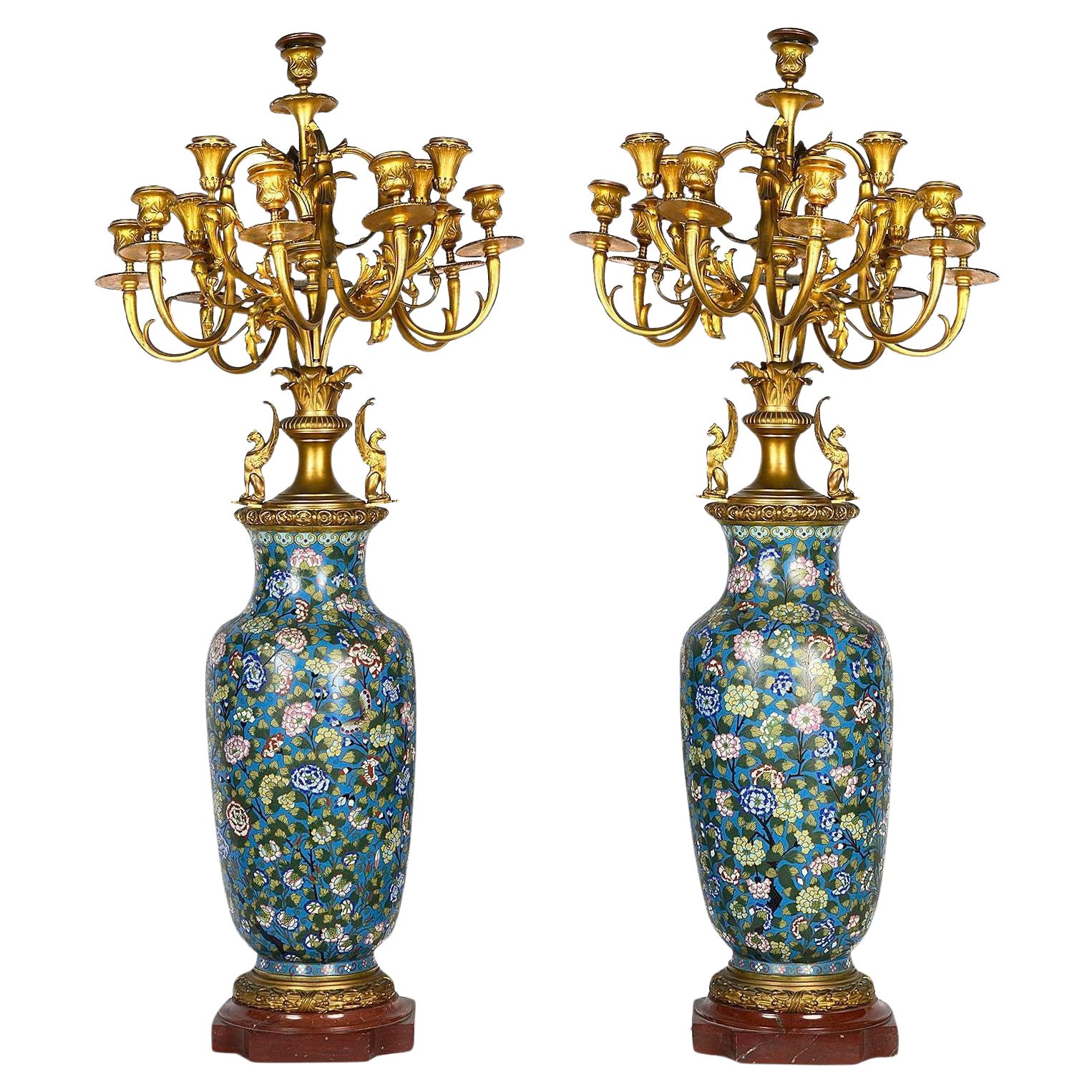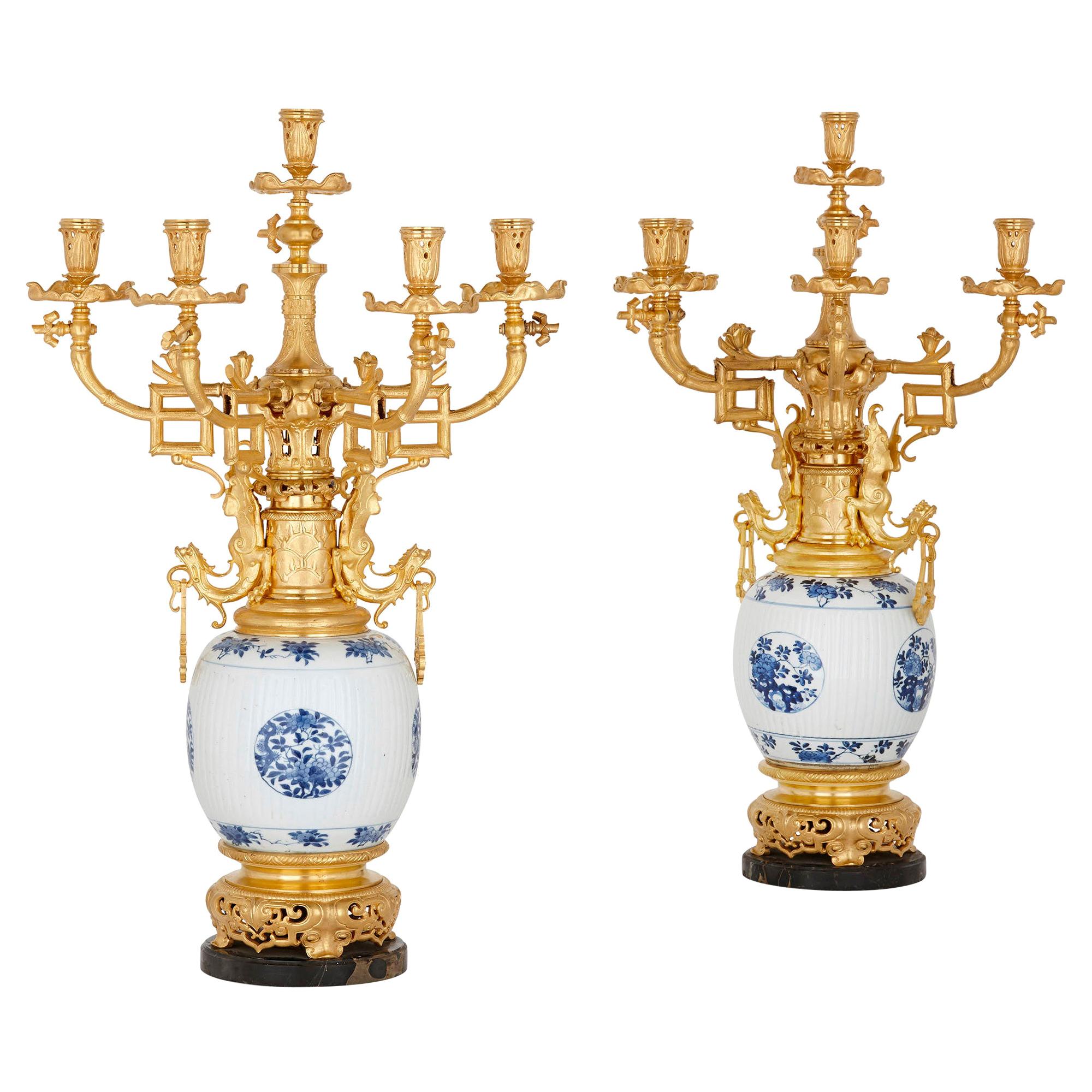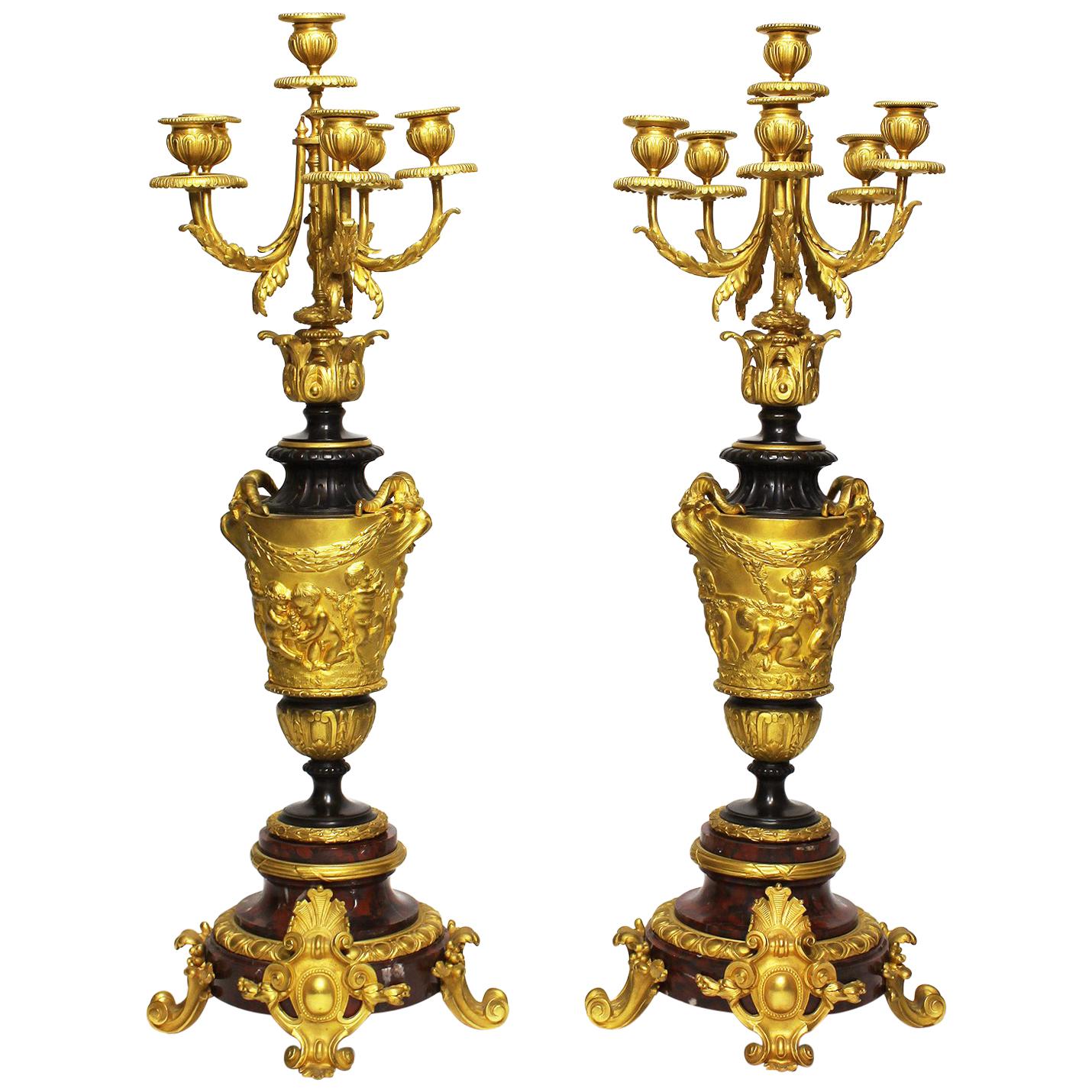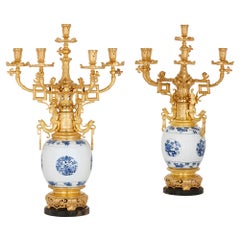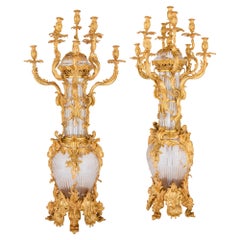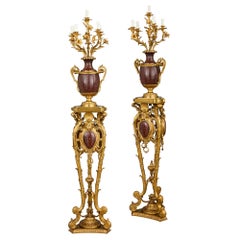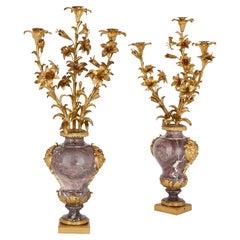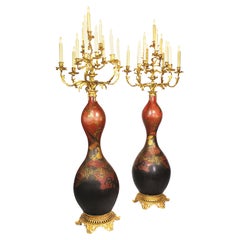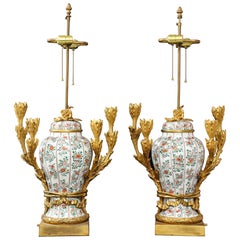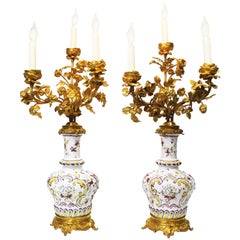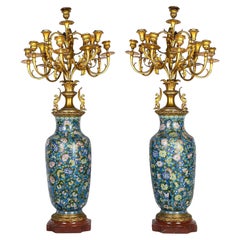Items Similar to Pair of Monumental Large Japanese French Imari Porcelain Ormolu Candelabra
Want more images or videos?
Request additional images or videos from the seller
1 of 21
Pair of Monumental Large Japanese French Imari Porcelain Ormolu Candelabra
$478,129.91per set
£350,000per set
€410,955.05per set
CA$671,763.44per set
A$734,998.99per set
CHF 379,257.43per set
MX$8,801,533.95per set
NOK 4,814,852.34per set
SEK 4,511,052.42per set
DKK 3,068,982.01per set
About the Item
Pair of Monumental Large Japanese French Imari Porcelain Ormolu Candelabra
Porcelain: Japanese, 18th Century
Ormolu: French, Mid-19th Century
Height 260cm, diameter 86cm
This exceptional pair of antique candelabra showcases a remarkable marriage of French and Japanese artistry. Grand in both scale and design, they embody the 19th century taste for blending Eastern and Western aesthetics. During this period, Japanese porcelain was frequently exported to Europe, where it was enriched with elaborate gilt-bronze, or ormolu, mounts in the French decorative style - an influence clearly reflected in this exquisite duo.
Each candelabrum features a body crafted from fine Imari porcelain, originating from Japan’s famed Arita kilns. Celebrated for its vivid palette of cobalt blue underglaze with iron-red, gold, and other coloured enamels, Imari porcelain first captivated European collectors in the early 1600s. The surfaces of these examples are richly decorated with dynamic scenes enclosed within black borders, surrounded by intricate blue scrollwork and vibrant floral motifs in red and gold - hallmarks of the style’s opulent visual language.
The porcelain bodies gently taper into elongated necks, crowned with ornate gilt-bronze mounts that branch into multiple scrolling candle arms. Each arm is adorned with delicately cast foliage and flower details, ending in elegantly modelled drip pans and candle holders.
Supporting the candelabra are beautifully cast ormolu bases resting on scrolling feet, adorned with vine leaves and clusters of grapes, a classical nod to Bacchus, the Roman deity of wine and festivity. The ensemble is completed by shaped wooden plinths, designed to elevate and emphasise their striking presence.
Merging Japanese artistry with French opulence, this distinguished pair of candelabra perfectly captures the cosmopolitan spirit of 19th-century decorative art. A statement piece of refined taste, it would make a sophisticated focal point in any elegant interior.
- Dimensions:Height: 102.37 in (260 cm)Diameter: 33.86 in (86 cm)
- Sold As:Set of 2
- Style:Napoleon III (In the Style Of)
- Materials and Techniques:
- Place of Origin:
- Period:
- Date of Manufacture:18th/ Mid-19th Century
- Condition:Wear consistent with age and use.
- Seller Location:London, GB
- Reference Number:Seller: 176571stDibs: LU956347083362
About the Seller
5.0
Recognized Seller
These prestigious sellers are industry leaders and represent the highest echelon for item quality and design.
Established in 1975
1stDibs seller since 2012
417 sales on 1stDibs
Typical response time: 8 hours
Associations
The British Antique Dealers' AssociationInternational Confederation of Art and Antique Dealers' Associations
- ShippingRetrieving quote...Shipping from: London, United Kingdom
- Return Policy
Authenticity Guarantee
In the unlikely event there’s an issue with an item’s authenticity, contact us within 1 year for a full refund. DetailsMoney-Back Guarantee
If your item is not as described, is damaged in transit, or does not arrive, contact us within 7 days for a full refund. Details24-Hour Cancellation
You have a 24-hour grace period in which to reconsider your purchase, with no questions asked.Vetted Professional Sellers
Our world-class sellers must adhere to strict standards for service and quality, maintaining the integrity of our listings.Price-Match Guarantee
If you find that a seller listed the same item for a lower price elsewhere, we’ll match it.Trusted Global Delivery
Our best-in-class carrier network provides specialized shipping options worldwide, including custom delivery.More From This Seller
View AllPair of Chinese Porcelain and French Chinoiserie Style Gilt Bronze Candelabra
Located in London, GB
Pair of Chinese porcelain and French Chinoiserie style gilt bronze candelabra
Chinese and French, 19th Century
Height 72cm, width 47cm, depth 35cm
This superb pair of candelabra...
Category
Antique 19th Century French Chinoiserie Candelabras
Materials
Ormolu, Bronze
Pair of Large French Rococo Style Glass and Gilt Bronze Candelabra
Located in London, GB
Pair of large French Rococo style glass and gilt bronze candelabra
French, 20th Century
Height 160cm, width 78cm, depth 73cm
This striking pair of 20th century French candelabra s...
Category
20th Century French Louis XV Floor Lamps
Materials
Ormolu
Large Pair of Antique French Marble and Ormolu Candelabra by Paul Sormani
By Paul Sormani
Located in London, GB
Large pair of antique French marble and ormolu candelabra by Paul Sormani
French, Late 19th Century
Height 210cm, width 40cm, depth 34cm
Crafted in the elegant Louis XVI style by P...
Category
Antique Late 19th Century French Louis XVI Floor Lamps
Materials
Marble, Ormolu
Pair of Large Rococo Style Gilt-Bronze and Marble Candelabra
By Eugene Bazart
Located in London, GB
Pair of large Rococo style gilt-bronze and marble candelabra
French, Late 19th Century
Measures: height 106cm, width 46/53cm, depth 23cm
These superb antique candelabra were mad...
Category
Antique Late 19th Century French Louis XV Candelabras
Materials
Marble, Ormolu
Pair of Monumental Gilt Bronze and Glass Floor Standing Candelabra
Located in London, GB
Pair of monumental gilt bronze and glass floor standing candelabra
Crafted in the neoclassical style, this pair of floor-standing candelab...
Category
20th Century French Neoclassical Candelabras
Materials
Ormolu, Bronze
Pair of Large Gilt Bronze and Marble Candelabra
Located in London, GB
These exceptional, large pair of red marble and gilt bronze candelabra is opulently decorated finely-cast neoclassical style decorations. Each candelabrum is formed as a red marble vase...
Category
Antique 19th Century French Louis XVI Candelabras
Materials
Marble, Ormolu, Bronze
$61,388 / set
You May Also Like
Pair 19th Century Japanese Imari Porcelain & Gilt-Bronze Torchere Candelabra
By Imari Porcelain
Located in Los Angeles, CA
A fine Pair of 19th century Japanese Imari Porcelain and French Gilt-Bronze Mounted Thirteen-Light Celadon Torchere Candelabra. The bottle-shaped Japonisme vases with a Royal red background, decorated with parcel-gilt and black soaring eagles in the hunt within a forestall scene. Each Vase fitted and surmounted with a French 19th century Louis XV Style 13-Light scrolled candelabrum and all raised on a circular pierced gilt-bronze plinth. circa: 1880.
Imari Porcelain (????) is the name for Japanese porcelain wares made in the town of Arita, in the former Hizen Province, northwestern Kyushu. They were exported to Europe extensively from the port of Imari, Saga, between the second half of the 17th century and the first half of the 18th century. The Japanese as well as Europeans called them Imari. In Japanese, these porcelains are also known as Arita-yaki (???). Imari or Arita porcelain has been continously produced up through the present day.
Characteristics
Though there are many types of Imari, Westerners' conception of Imari in the popular sense is associated only with a type of Imari produced and exported in large quantity in mid-17th century. This type is called Kinrande. Kinrande Imari is colored porcelain with cobalt blue underglaze and red and gold overglaze. The color combination was not seen in China at that time. Traditional Ming dynasty color porcelain used dominantly red and green, probably due to scarcity of gold in China, whereas gold was abundant in Japan in those days. The subject matter of Imari is diverse, ranging from foliage and flowers to people, scenery and abstractions. Some Imari design structures such as kraak style were adopted from China, but most designs were uniquely Japanese owing to the rich Japanese tradition of paintings and costume design. The porcelain has a gritty texture on the bases, where it is not covered by glaze. There is also blue and white Imari. Kakiemon style Imari is another type of Imari, but it tends to be categorized separately in Europe.
History
"Imari" was simply the trans-shipment port for Arita wares. It was the kilns at Arita which formed the heart of the Japanese porcelain industry.
Arita's kilns were set up in the 17th century, when kaolin was discovered in 1616 by the immigrant Korean potter, Yi Sam-pyeong (1579–1655). (He may also be known by the name, "Kanage Sambei".) Yi Sam-Pyeong, along with his extended family of 180 persons, left Korea on the offer of a privileged position in Japan. This decision was made after the occurrence of certain Japanese invasions of Korea. After Yi Sam-Pyeong's discovery, his kilns began to produce revised Korean-style blue and white porcelains, known as "Shoki-Imari".
In the mid-17th century there were also a lot of Chinese refugees in Northern Kyushu due to the turmoil on Chinese continent, and it is said one of them brought coloring technique to Arita. Thus Shoki-Imari developed into Ko-KutaniImari. Ko-Kutani was produced around 1650 for both export and domestic market. Blue and white porcelain continued to be produced and they are called Ai-Kutani. Ko-Kutani Imari for the export market usually adopted Chinese design structure such as kraak style, whereas Ai-Kutani for the domestic market were highly unique in design and are accordingly valued very much among collectors.
Ko-Kutani style evolved into Kakiemon style Imari, which was produced for about 50 years around 1700. Imari achieved its technical and aesthetic peak in Kakiemon style, and it dominated European market. Blue and white Kakiemon is called Ai-Kakiemon. Kakiemon style transformed into Kinrande in the 18th century. Kinrande used blue underglaze and red and gold overglaze, and later some other colors.
Imari began to be exported to Europe because the Chinese kilns at Ching-te-Chen were damaged in the political chaos and the new Qing dynasty government stopped trade in 1656–1684. Exports to Europe were made through the Dutch East India Company, but the designation "Imari Porcelain" in Europe connotes Arita wares of mostly Kinrande Imari.
Export of Imari to Europe stopped in mid-18th century when China began export to Europe again, since Imari was not able to compete against China due to high labor cost. By that time, however, both Imari and Kakiemon style were already so popular among Europeans, Chinese export porcelain copied both Imari and Kakiemon style, which is called Chinese Imari. At the same time, European kilns, such as Meisen also tried to copy Imari and Kakiemon.
Export of Imari surged again in late 19th century (Meiji era) when Japonism flourished in Europe. Thus in western world today, two kinds of Imari can...
Category
Antique 19th Century Japanese Japonisme Floor Lamps
Materials
Bronze, Ormolu
$24,850 Sale Price / set
49% Off
Pair of Chinese Famille Vert Porcelain & French Ormolu Mounted Candelabra Lamps
Located in New York, NY
A Magnificent Pair of 19th Century French Ormolu-Mounted Chinese Export Porcelain Candelabra Lamps with Famille Vert Enamel Flower Decoration. Each vase is of baluster form with a do...
Category
Antique 1880s French Louis XVI Table Lamps
Materials
Ormolu
Pair of 19th Century Gilt-Bronze & Faience Porcelain Table Lamp Candelabras
Located in Los Angeles, CA
A fine pair of French 19th-20th century Louis XV style gilt bronze and Faience porcelain three-light candelabra table lamps. The ovoid porcelain urn hand decorated in floral burgundy...
Category
Antique Early 1900s French Louis XV Table Lamps
Materials
Bronze, Ormolu
Large pair French Cloisonné + ormolu candelabra, 19th Century.
By Ferdinand Barbedienne
Located in Brighton, Sussex
A wonderful quality pair of late 19th Century French Cloisonné enamel and gilded ormolu 12 branch candelabra. Having wonderful bold colouring to the floral design enamel decoration, ...
Category
Antique Late 19th Century French Candelabras
Materials
Enamel, Ormolu
Pair of 19th Century Rococo Ormolu & Griotte Marble Candelabra, Barbedienne
By Ferdinand Barbedienne
Located in Los Angeles, CA
A fine pair of French 19th century Rococo Revival style gilt bronze and Rouge Griotte marble six-light candelabra attributed to Ferdinand Barbedienne (French, 1810-1892) After a mode...
Category
Antique Late 19th Century French Rococo Revival Table Lamps
Materials
Griotte Marble, Bronze, Ormolu
$12,950 Sale Price / set
30% Off
A Pair of Late 19th Century Ormolu and Rouge Marble Ten-Light Candelabras
Located in New York, NY
A central baluster vase carved in rouge marble, held by rams mask mounts, issues ten highly decorative candle branches adorned with foliage and vines all resting on a triform base wi...
Category
Antique Late 19th Century French Napoleon III Table Lamps
Materials
Marble, Bronze, Gold Leaf
